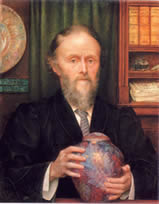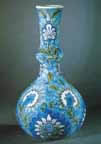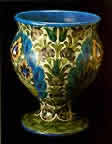|
"Genealogy:
Tracing yourself back to people better than you are"
-John Garland Pollard |
| Henry Shelley Dalbiac |
| Augustus De Morgan |
| William De Morgan |
| Lord Marley |
| Sampson Perry |
| Frank Perrycoste |
| Sir James Pitcairn |
| Dukes Of Roxburghe |
| Charles Augustus West |
|
William De Morgan
He was born in Chester on November 16, 1839, the son of the eminent mathematician Augustus De Morgan. His mother was Sophia Frend, a writer and a suffragette. At the age of twenty he entered the Royal Academy school where he met first Morris and, through him, other members of the Pre-Raphaelite movement who encouraged him to paint in the Pre-Raphaelite style. However, he soon gave up the study of fine arts and turned instead to stained glass and then pottery but by 1872 he had shifted his entire interest to ceramics. He set up a pottery works in Chelsea where he stayed until 1881. This was his most prolific period as an artistic potter. He experimented with different lustres and glazes being heavily influenced by Persian and Moresque designs and rediscovered methods of making the intense greens and blues used in Majolica wares. In 1882 he moved to Merton Abbey, being closer to William Morris' works. He won many commissions for his work, including supplying the tiles for the Czar of Russia's yacht. In 1887 he married Evelyn Pickering who as Evelyn De Morgan was an important Pre-Raphaelite artist in her own right. A portrait by her of her husband hangs in the National Portrait Gallery. They both became interested in, and involved with, many of the social issues of the day including spiritualism (an interest inherited from William's parents), the women's suffrage movement, pacifism and prison reform. Later in life and with failing health they spent long periods in Italy. William took to writing and wrote a number of successful novels including Joseph Vance and Alice-For-Short. There is a permanent exhibition of his work in the De Morgan Centre, south west London. Collections of his work also exist in many museums, including the Victoria and Albert Museum and the William Morris Gallery in London. Not surprisingly, his work is very collectable today with individual tiles of his selling for many hundreds of pounds.
|
 William
De Morgan was probably the most important and innovative potter of the
19th century and, with his friend William Morris, was a leading figure
in the Arts and Crafts Movement.
William
De Morgan was probably the most important and innovative potter of the
19th century and, with his friend William Morris, was a leading figure
in the Arts and Crafts Movement. 

